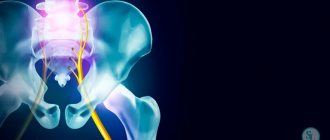The tarsal or tarsal canal is a canal between the medial malleolus, talus and calcaneus, and the flexor tendon retinaculum, a connective tissue structure that runs from the medial malleolus to the calcaneus. The channel contains:
- tibialis posterior tendon;
- flexor digitorum longus tendon;
- posterior tibial artery and vein;
- tibial nerve;
- flexor tendon of the thumb.
The tibial nerve divides into two terminal branches—the medial and lateral plantar nerves—as it passes through the tarsal canal. The medial calcaneal nerve arises from the tibial nerve near or superior to the flexor retinaculum.
Tarsal tunnel syndrome (TTS) is a rare compressive neuropathy of the tibial nerve or one of its branches as it passes under the flexor retinaculum.
Friends, this and other questions will be discussed in detail at the Neurodynamics seminar. Find out more...
In the literature on TTS, the tibial nerve is also called the posterior tibial nerve, so TTS is also known as posterior tibial neuralgia. Some authors refer to compression of the deep branch of the peroneal nerve as “anterior tarsal tunnel syndrome.” This article focuses on TTS as a condition that results in compression of the tibial nerve or its branches.
Epidemiology/Etiology
The incidence is unknown. A higher prevalence of TCS has been reported among women than among men. Moreover, this occurs at any age. Causes of TCS include:
- Repetitive activities that strain this area, such as running, long walking, or standing.
- Injuries such as fractures, dislocations, or sprains.
- Varus or valgus heel.
- Fibrosis.
- Excess body weight.
- Pathologies occupying space in the tarsal canal area, such as tumors, edema, osteophytes or varicose veins.
- Tendinitis.
- Systemic diseases that cause inflammation of the ankle joint or disorders of its innervation (for example: diabetes, arthritis).
Many cases (20-40%) are idiopathic.
Characteristics/Clinical picture
Common symptoms of TTS include paresthesia (burning, numbness, or tingling) in the tibial, lateral, and/or medial plantar nerves. There may be burning, tingling, or pain along the medial ankle and plantar surface of the foot, as well as localized tenderness behind the medial malleolus. Symptoms usually worsen with forced eversion and dorsiflexion of the foot. When the medial plantar nerve is isolated, patients may experience stabbing pain in the midfoot, which is typically seen in middle-aged runners. If the condition is progressive or chronic, there may be muscle weakness of the abductors and flexors of the fingers. In more serious cases, muscle atrophy occurs. Patients may also experience night pain that reduces sleep quality, as well as severe pain when walking for long periods of time.
Survey
It is important to take a thorough history. The physical therapist should learn about the following:
- Mechanism of injury – was there trauma, sprain or overuse?
- Duration and location of pain and paresthesia?
- Weakness or difficulty walking?
- Are back and buttock pain associated with distal symptoms?
- Does the pain get worse, stay the same, or get better?
Key symptoms
- Paresthesia or burning in the area of the distal branches of the tibial nerve.
- Prolonged walking or standing often worsens the patient's symptoms.
- Dysesthesia (an abnormal or unpleasant sensation) occurs at night and can interfere with sleep.
- Muscle weakness.
Observation
- Atrophy of the abductor pollicis may be noticeable.
- Assessment of the arches of the feet.
- Position of the talus and calcaneus.
Gait Analysis
- Examine for abnormalities (excessive pronation/supination, excessive inversion/eversion, antalgic gait, etc.).
Sensitivity assessment
- Testing surface sensitivity, sense of discrimination.
- Sensitivity will be impaired in the area of innervation of the tibial nerve.
Palpation
- Tenderness on palpation between the medial malleolus and the Achilles tendon (palpation is painful in 60-100% of patients).
Movement amplitude
- Focus on the range of motion of your ankle and toes.
Manual muscle testing
- Decreased strength usually occurs in the late stages of STS.
- First, the abductors of the fingers are turned off, and then the short flexors of the fingers.
Special tests
Tinnel's sign
- Percussion in the area of the tarsal canal leads to the spread of paresthesia in the distal direction (occurs in more than 50% of patients).
Dorsiflexion-eversion test
- Place the patient's foot in the dorsiflexion position and hold it in eversion for 5-10 seconds. This results in the patient becoming symptomatic.
Electromyography
- The presence of an isolated lesion of the tibial nerve in the tarsal canal is confirmed by measuring the velocity of impulses along sensory and motor fibers.
- Assessment of conduction along sensory fibers of the medial and lateral plantar nerves. This is best done by recording from the tibial nerve just above the flexor retinaculum and stimulating the ball of the foot. When surface electrodes are used, responses to stimulation are of low amplitude.
- Measuring conduction velocity along motor fibers by recording the distal latency of the abductor pollicis is a much simpler but less sensitive method. An important finding of electromyography is the detection of axonal damage when readings are recorded from the distal muscles innervated by the tibial nerve.
How to diagnose the disease?
Tunnel neuropathy of the peroneal nerve can be suspected based on typical complaints (weakness of the lower leg muscles, numbness of the outer surface of the lower leg and dorsum of the foot, burning shooting pain in the leg below the knee level). The diagnosis can be confirmed using stimulation electroneuromyography (ENMG).
This study allows using an electric current to “ring” the sciatic, tibial and peroneal nerves along their entire length and identify the local area of damage. In the place where the nerve is subjected to mechanical compression, its myelin sheath is damaged, which leads to a decrease in the speed of propagation of the nerve impulse along this segment of the nerve trunk.
It is this parameter during ENMG that is the most informative for establishing the diagnosis of tunnel neuropathy.
Rating scales
- Functionality Questionnaire of the Foot and Ankle (FAAM). The FAAM is a reliable, sensitive, and valid measure of physical function for people with a wide range of musculoskeletal disorders of the leg, ankle, and foot.
- Tarsal tunnel syndrome severity rating scale.
| Symptoms | None | In some ways | Present |
| Pain, spontaneous or with movement | 2 | 1 | 0 |
| Burning pain | 2 | 1 | 0 |
| Tinnel's sign | 2 | 1 | 0 |
| Sensory impairment | 2 | 1 | 0 |
| Muscle atrophy or weakness | 2 | 1 | 0 |
Treatment for tarsal tunnel syndrome
Medication support
To optimize recovery and reduce functional impairment in patients with TTS, pharmacological methods are used in combination with physical therapy. These include:
- NSAIDs.
- Corticosteroid injections.
Surgery
Surgery is indicated for patients who have not benefited from conservative treatment such as physical therapy and have symptoms that significantly affect their daily life. People with severe disorders tend not to respond to conservative treatment and often require surgery. Godges and Klingman identified several characteristics that were associated with successful response to surgery. These include young age, short disease duration, no history of ankle problems, early diagnosis, and specific etiology.
- Decompression of the tibial nerve.
- Cryosurgery.
Physical therapy
There is a lack of high-level evidence regarding physiotherapy treatment for tarsal tunnel syndrome. Further research is needed to identify specific rehabilitation exercises for patients with TCS. There are small randomized controlled trials that include analyzes of the effectiveness of specific treatments.
When to see a doctor
Do not expect that everything will go away on its own; if you do not consult a doctor in a timely manner, atrophy of the limbs may begin to develop. If your profession involves working at a computer, you stand at a machine for a long time, or you work as a driver, you are at increased risk. When the first symptoms appear (nighttime, vegetative, pain), you need to consult a specialist.
Neurologists at JSC Meditsina (clinic of Academician Roitberg) have extensive experience in treating such problems. Our clinic is located in the center of Moscow, within walking distance are the Mayakovskaya, Belorusskaya, Novoslobodskaya, Tverskaya, and Chekhovskaya metro stations.
Conservative treatment
| Stages | Physical agents | Orthotics | Therapeutic exercises | Manual therapy |
| Acute stage Goal: reduce pain and swelling |
|
|
|
|
| Subacute stage Goal: Increase flexibility and improve straight leg test | See above | See above | Tibialis Posterior Stretch | See above |
| Recovery stage Goal: develop symmetrical flexibility, improve straight leg test and functional mobility | See above | See above | Tibialis Posterior Stretch | See above |
One of the mechanical causes of TCS is thought to be excessive calcaneal eversion, leading to collapse of the medial arch (overpronation), which exerts a traction effect on the tibial nerve and leads to compression under the flexor retinaculum. Scherer believes that custom orthoses can correct overpronation and therefore reduce stress on the tibial nerve. Although there are no clinical trial results to support the effectiveness of orthopedic treatment, it may be an important modality to consider when treating patients with TCS.
A number of articles listed the main methods of conservative treatment of STS as a guide for rehabilitation, but did not provide patient outcomes.
Diagnostics
To correctly diagnose the disease, the doctor communicates with the patient and takes into account his complaints. Afterwards, the limbs are examined, tests and instrumental examination are prescribed.
The main tests include:
- Tinnel;
- Vest;
- Fallena.
The patient is also prescribed an ultrasound, computed tomography, and MRI, which makes it possible to determine (or refute) the presence of tumors. Before prescribing treatment, the specialist is faced with the task of determining how affected the nerve is. For this purpose, electroneuromyography is prescribed.
Postoperative treatment
| Phases | Period | Goals | Intervention |
| Phase I | 1-3 weeks |
|
|
| Phase II | 3-6 weeks |
|
|
| Phase III | 6-12 weeks |
|
|
Incidence (per 100,000 people)
| Men | Women | |||||||||||||
| Age, years | 0-1 | 1-3 | 3-14 | 14-25 | 25-40 | 40-60 | 60 + | 0-1 | 1-3 | 3-14 | 14-25 | 25-40 | 40-60 | 60 + |
| Number of sick people | 0 | 0 | 1 | 10 | 10 | 30 | 20 | 0 | 0 | 5 | 100 | 100 | 80 | 70 |
Case study
Romani et al reported their results in a 22-year-old lacrosse player with tarsal tunnel syndrome. The player suffered a mild eversion ankle sprain that was successfully treated with conservative treatment. Following a recurrent ankle sprain, the patient made the decision to compete in the NCAA Tournament, which led to an exacerbation of symptoms and, ultimately, to surgery. The 13-week rehabilitation program included: RICE, range of motion maintenance, balance exercises, therabend exercises, aquatic therapy and walking, which eventually progressed to running. At the end of week 13, the athlete returned to lacrosse, competing at the elite level.
Dr. Karen Hudes conducted a separate case study on the conservative approach to treating TTS. A 61-year-old patient diagnosed with tarsal tunnel syndrome reported pain and discomfort in the medial ankle area (verbal rating scale 9/10). Initial treatment included orthopedic techniques for the first ten weeks, after which the patient reported little change in symptoms. Following failure of orthopedic therapy, treatments such as transverse friction massage, high-velocity, low-amplitude manipulation of the talonavicular joint, and cuboid mobilization were used twice weekly. The patient's symptoms began to improve after 3 weeks, resolved by week 6 with occasional relapses of pain, and resolved completely by week 12. The patient reported no pain during the ten-month follow-up.
Elimination of exacerbations and complications by surgical method
If all the steps taken do not give a lasting result, the disease periodically worsens, and surgical intervention will be required. A drastic measure will prevent a decrease and complete loss of motor functions. Surgery is also indicated for the development of syndrome after a bone fracture with displacement of bone fragments.
The operation is performed by orthopedic surgeons, neurosurgeons, and general surgeons. Having numbed the surgical field, the specialist makes a dissection of the skin, subcutaneous tissue and ligament. Carefully examines the carpal tunnel, eliminates compression of the nerve fibers by hypertrophied ligaments, after which the incision is sutured.
In addition to the open incision technique, a new technique is used - endoscopic surgery. A small device with a camera equipped with a magnifying lens is inserted into a narrow depression made in the wrist. Special surgical instruments are inserted into the incision in the palm. Medical equipment helps the doctor navigate the anatomical structure of the hand and carry out the necessary manipulations with the least complications for the patient.
The consequences of surgical treatment are long-term rehabilitation. It may take up to 2 months to restore functional abilities.








